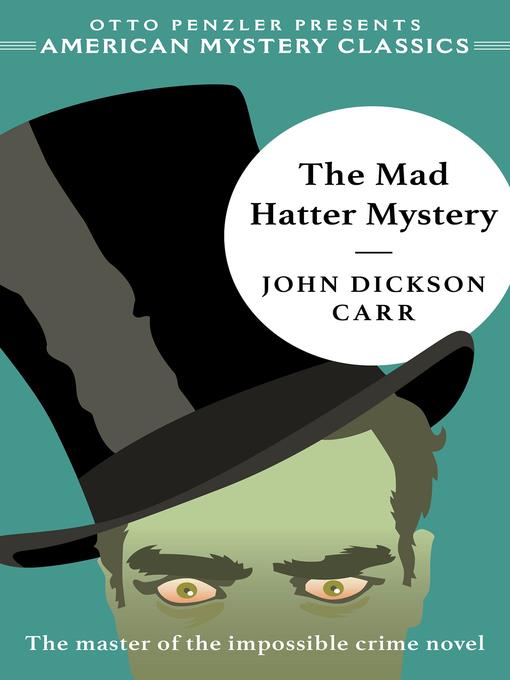
The Mad Hatter Mystery
Dr. Gideon Fell Series, Book 2
کتاب های مرتبط
- اطلاعات
- نقد و بررسی
- دیدگاه کاربران
نقد و بررسی

Starred review from March 4, 2019
Carr’s series sleuth, Dr. Gideon Fell, shows off his brilliance in this sterling entry in the American Mystery Classics series, originally published in 1933. Chief Inspector Hadley consults Fell on the case of Sir William Bitton, a book collector who stumbled on the find of a lifetime, the manuscript of a lost Edgar Allan Poe story, believed to have been the first the author wrote. Someone has stolen the document from Bitton’s London study, but before Fell and Hadley can investigate, they learn that one of the possible suspects has been found murdered at the Tower of London, killed with a crossbow bolt. The body was adorned with an opera hat that was stolen from Bitton previously, the second hat that had been stolen from him in a week. The hat robberies were part of a series of thefts committed by the person dubbed the Mad Hatter by Bitton’s journalist nephew. Could the Mad Hatter also be the thief who stole the Poe manuscript? Readers may be moved to reread the book to note how artfully Carr (1906–1977) plants the clues to the killer’s identity in plain sight.

May 1, 2019
Forget any Alice connection; in 1932 London, the Mad Hatter is a thief who steals gentlemen's hats and puts them in amusing places, such as on one of the Trafalgar Square lion statues. When successful amateur sleuth Dr. Gideon Fell learns of the case from the police, he turns it down as a trifle not worth his time, until hearing that a Hatter victim has had a much more valuable item stolen: a newly discovered Edgar Allan Poe manuscript. The need for Fell's talents is cemented when someone involved with the case is found murdered, a stolen hat atop the corpse. Fell leaves no stone unturned, and the twists and red herrings involved indeed require the mental gymnastics that series editor Penzler's introduction notes are necessary on the part of Golden Age favorite Carr's readers. Anglophiles (the British class system is virtually a character here) and those who like a slice of literary history are the audience for this bibliomystery with a side of top hats. This latest from Penzler's new American Mystery Classics series was originally published in 1933.(Reprinted with permission of Booklist, copyright 2019, American Library Association.)

April 1, 2019
Dr. Gideon Fell, that beloved, avuncular detective from the genre's golden age, returns in this reprint of his second case, originally published in 1933. Otto Penzler's brief introduction, which emphasizes Carr's unrivaled reputation nearly 50 years after his death as the master of the locked-room mystery, hails this one for including "an impossible crime." The murder here doesn't involve a locked room; instead, it pushes whimsical absurdities to a sinister extreme. As the tale begins, Dr. Fell, just arrived in London, hears of two notable thefts: the disappearance of an original Poe story from the possession of Sir William Bitton, who'd unearthed it in one of Poe's homes in Philadelphia, and a rash of thefts of headgear--a police constable's helmet, a barrister's wig, Sir William's top hat--by some wag who relocates his prizes to new places sure to offend the victims and amuse everyone else. News swiftly follows that Sir William's nephew, journalist Philip Driscoll, who's been milking the Mad Hatter story for all it's worth, has been found dead at Traitors' Gate, in the densely fogged-up Tower of London, stabbed or shot by a crossbolt Sir William's brother and sister-in-law, Lester and Laura Bitton, had recently brought home from a trip abroad. As usual with Carr (The Hungry Goblin, 1972, etc.), the plotting is denser than a London particular. But this time there's nothing impossible about the mystery, just plenty of outr� details. In truth, this is middling Carr, unable to sustain its atmosphere through the increasingly labored revelations of its second half, and its principal red herring, the theft of all those hats, is more vivid, more baffling, and more logically satisfying in its elucidation than the murder of Philip Driscoll--a flaw Carr duly corrected in the masterpieces that followed: The Three Coffins, The Burning Court, The Crooked Hinge, and, as Carter Dickson, The Judas Window. Even so, fans won't, and shouldn't, hesitate to dive back into a past in which whodunits could be so unsettlingly evocative in their setups and so unabashedly brainy in their solutions.
COPYRIGHT(2019) Kirkus Reviews, ALL RIGHTS RESERVED.

























دیدگاه کاربران